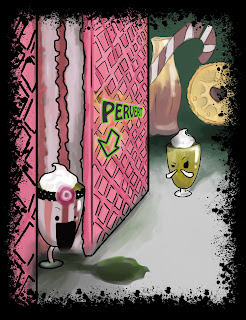Interesting level
design is the only thing that makes games playable. You can have the prettiest
of artwork, the most amazing interface but if you don’t have interesting
level’s it will all be work nothing. This is why industry hires a person for
this specific job role. Level designers use the same programs as we would use
but in a different way. They would use placeholder assets instead of game ready
ones in order to build a scene to test out its flow and direction. Below is an interesting video on the game
damnation, it describes that they wanted scale in their levels and at the start
of the project they though 4 stories was tall. They also make note that usually
games start with an overhead plan, something top down so they can map and area
more easily but with this game they did the concept art first. A peculiar way
to do it but they said that it was easier for them to extract from concept
images for the level design of this particular game. And so they started off
with this small village and then they advanced to make it a canyon with
multiple heights. It was then the level designer’s job to decipher the sketches
into workable levels.
“Level design is based on games that
which type of game it is. Before implementing we should be very clear that how
many players are in the game, how many levels we are going to create. First we
have to know that what we are going to make a 2D game or a 3D game. Because
here realism do some matters. In 2D games it doesn't matters too much but in 3D
games it gives a biggest difference. In 3D games we have to give a close
attention on Texturing, lighting, and all the other things would be in three
dimension.”
This extract is taken from http://www.ukessays.com/essays/video-games/2d-and-3d-games.php
where they compare 2D and 3D games. Now is not the most profound statement
about game design but in a way I disagree and agree. For me there isn’t a lot
of difference between a flash game and a xbox game. They have to share the same
components. It has to be centred in a universe, you have goals and conditions, and
you have tools to help you achieve these goals. Saying 2D games don’t have a
close attention to lighting and texturing is wrong. Games like Limbo work
highly with the interactive lighting as part of a gameplay element and it is
extremely important. Although other games...umm…not so much. Flash games are
the pornography for kids, its there when you are bored and have nothing better
to do than to sit in front of a screen playing with yourself…to graphic,
possibly.
Below is a powerpoint of level design from the lead designer of splash
damage the company that made Brink. It talks about interesting level design and
how it’s accomplished. Things like dynamic object, modular assets, it goes on
to explain about symmetrical layouts are balanced but boring where asymmetrical
layouts are much more interesting and promote asymmetrical game design – more
realistic. Also how designing maps for multiplayer is different than single, if
you think about it, it makes sense. It is hard to produce a game that is both
good at both, take brink for example it highly promotes interesting stylisation
and online gameplay yet in my opinion it failed as a game. I think this because
they made a big point about stylisation of your characters and they made it a
first person. Why would someone go to all that effort to create a character
that only others can see? It makes no sense in my eyes. They also made the
mistake of a rather weak single player as they thought the multiplayer would be
the key selling point. The thing is you can create a single player with no multiplayer
can it can become a huge hit. But to create just a multiplayer game with no
single is pretty impossible. Now I know online gaming does this all the time
but I’m talking about 360 and PS3 games. It’s a hard thing to do, assassin’s
creed now has a multiplayer but is entirety different from the single player
and I think that’s how you have to do it. Almost treat it as you are creating
two games, things have to be different. Assassins Creed single player missions
might be follow this guy but don’t be seen. The designers can strategically
place things to help the player. In a Multiplayer where they have to find their
targets it becomes a lot harder and you have to think about the world in a
different way.
I have no idea if I’m making sense anymore but below is a good link from
the world of level design, a really informative website and he sets challenges.
So if you are stuck for any summer work or just practice projects here he sets
4 week projects so you can try and mange your time effectively.
With Group Project over I'm actually writing blogs, damn it feels good to get some work done and I do enjoy blogs when they are interesting to talk about :D



